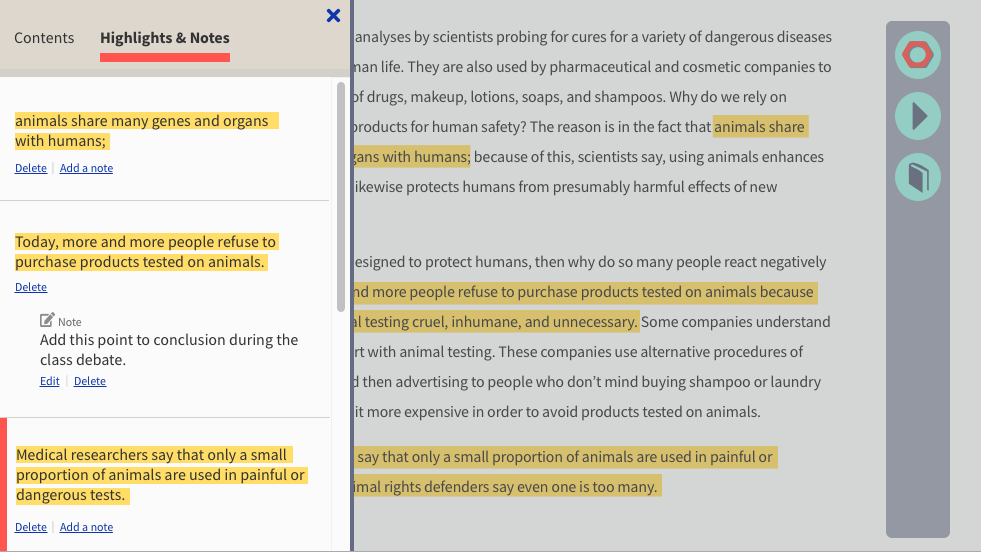Annotation
Annotating text is a strategy that leads to greater text comprehension because it promotes critical thinking skills and deeper engagement with a text. Annotation can include multiple strategies, but generally refers to highlighting interesting or important parts of a text and writing notes about the text as a person reads. Annotations typically include a person’s thoughts, reflections, and questions about a text as they read. Clusive allows users to annotate digital texts in an online environment.

Clusive readers can highlight the text and add notes as they read to mark important passages.
Research
Multiple studies provide evidence of the effectiveness of annotating text. Annotation has been shown to increase students’ memory of text, which leads to improved learning. Making notes in the margins encourages students to actively engage with text, identify important points, reflect, and generate comments that makes the text personally relevant to them. This deeper engagement with texts promotes student learning.
- One study compared two groups of college freshmen, where one group received annotation training and the other was trained in previewing text and generating their own questions and answers about a text. The groups were later tested on three different texts, and, on all three tests, the annotation group performed significantly better than the other group.
Simpson & Nist (1990) - Another study of college freshmen examined how students’ test scores changed over time, in relation to annotating text. These researchers found that increases in students’ test scores were positively correlated with the amount of annotation they performed, where the more a student annotated a text, the higher their test score.
Hwang, Wang, & Sharples (2007) - It is important to note that while evidence shows that annotation can play a key role in increasing students’ reading comprehension, annotation is not a skill that students tend to develop on their own. Rather, as described by one article that focused on high school students, annotation skills often need to be explicitly taught to students to help them learn to identify what aspects of a text are most important and should be annotated.
Porter-O’Donnell (2004)
Research also suggests that digital annotation may result in improved student outcomes when students are able to collaborate and discuss their annotations.
- Two studies on digital annotation found that students who are able to share annotations with each other perform better than students who are not. A study of 63 college freshmen found that students who used and shared their digital annotations scored significantly higher than students that studied individually and did not use annotation. Additionally, a study of college juniors in Taiwan learning English found that students who used and shared their digital annotations in groups of two to four performed better than individual students who used digital annotation.
Hwang, Wang, & Sharples (2007)
Chang & Hsu (2011) - Similarly, a third study of 267 community college freshmen found that students who used digital annotation tools in collaboration with small teams performed better on measures of reading comprehension and meta-cognitive skill, but not critical thinking.
Johnson, Archibald, Tenenbaum (2010)
Despite overall positive findings related to digital annotation and the importance of this feature for student learning, there have been some conflicting study results.
- For example, one study of 93 undergraduates examined the impact of annotation tools on reading comprehension for both digital academic essays and printed text. Students were asked factual questions and inferential questions about the essays. There were no impacts for the factual questions. However, for the inferential questions, annotation tools improved reading comprehension of the printed text, but not the digital text.
Ben-Yehudah & Eshet-Alkalai (2014)
Web Content Accessibility Guidelines (WCAG)
Annotation tools are not required for accessibility.
Universal Design for Learning (UDL) Guidelines
- UDL Checkpoint 3.3: Guide information processing and visualization
- UDL Checkpoint 6.3: Facilitate managing information and resources
Digital Annotation Examples
Understood.org has compiled a list of assistive technology software that can help students who struggle with reading, including several software programs that utilize annotation and highlighting tools.
Additionally, Common Sense Education has developed a list of “Top Tech for Digital Annotation.”
Further examples of digital annotation tools and features can be found in many eBook readers such as the Kindle, and eBook management software such as Calibre.
